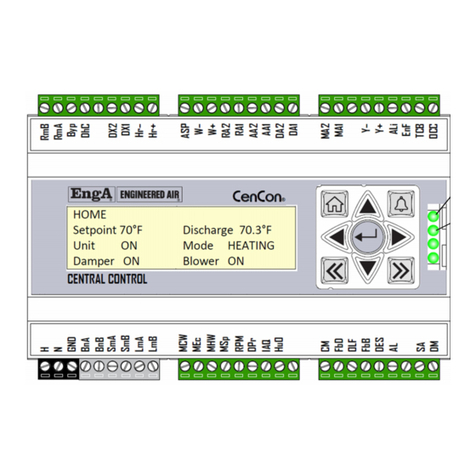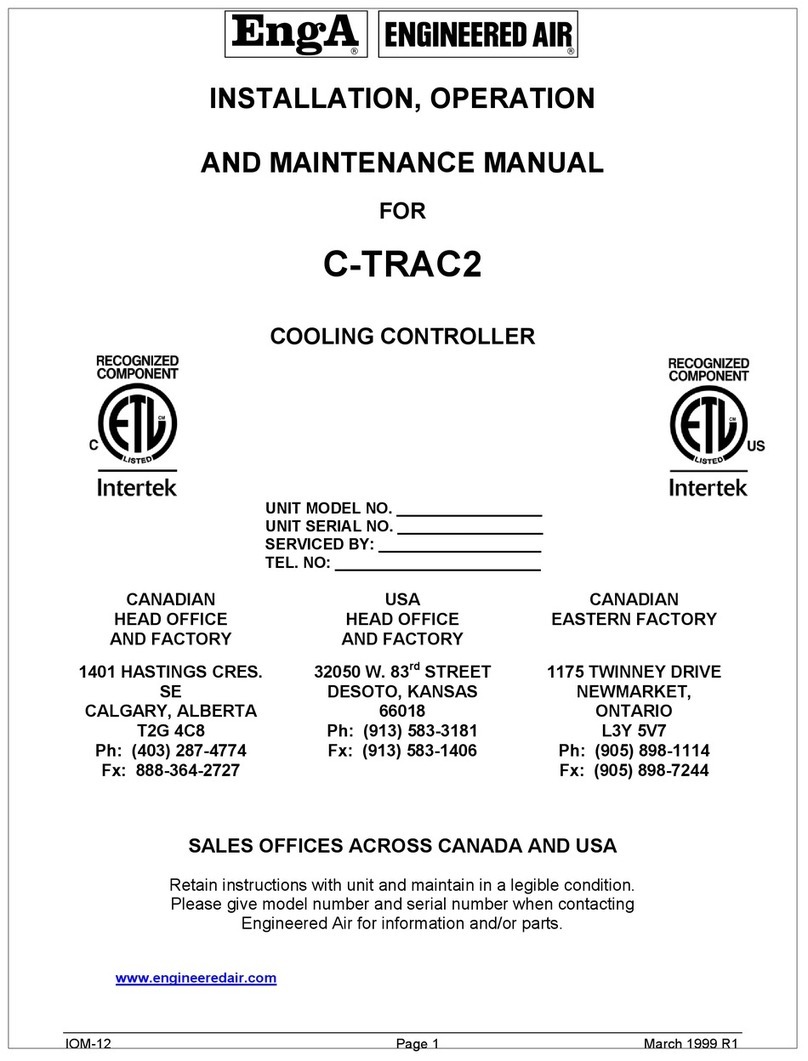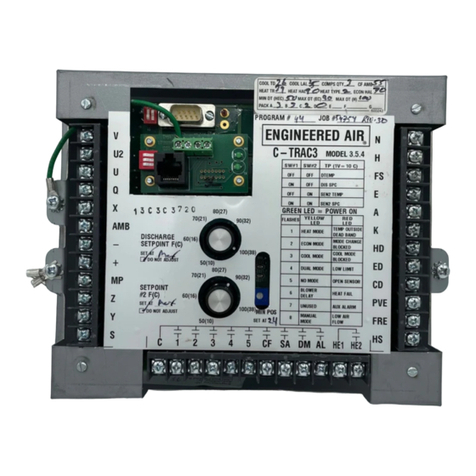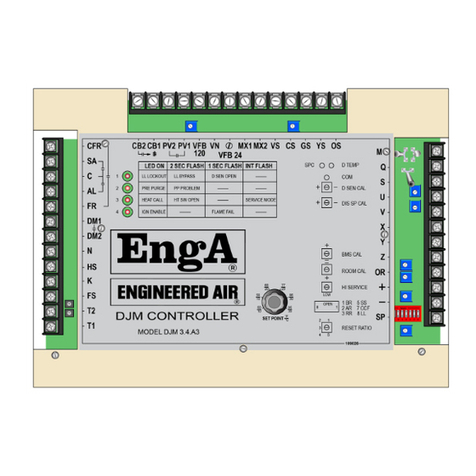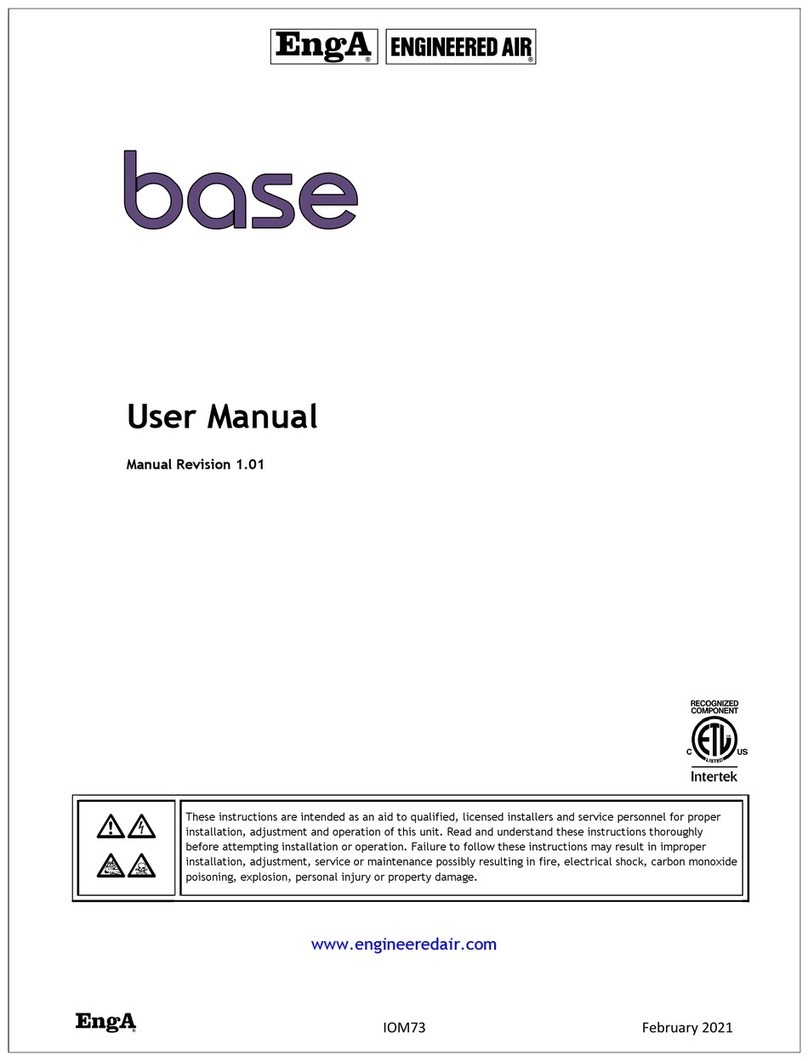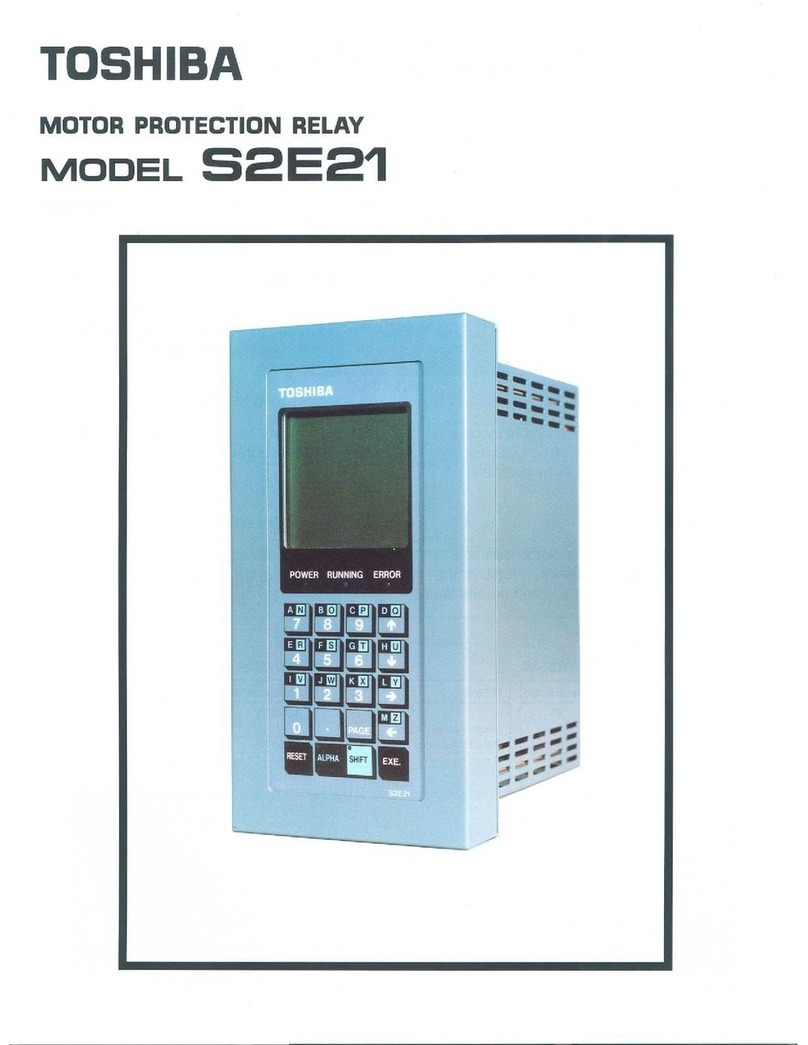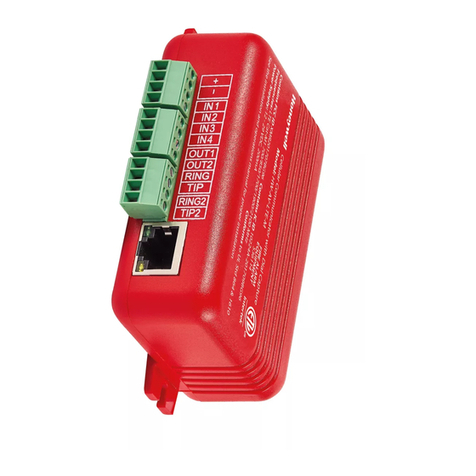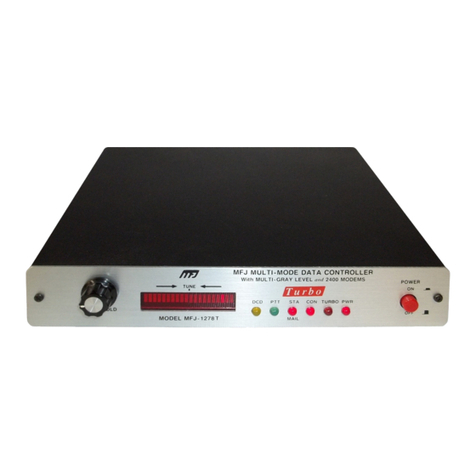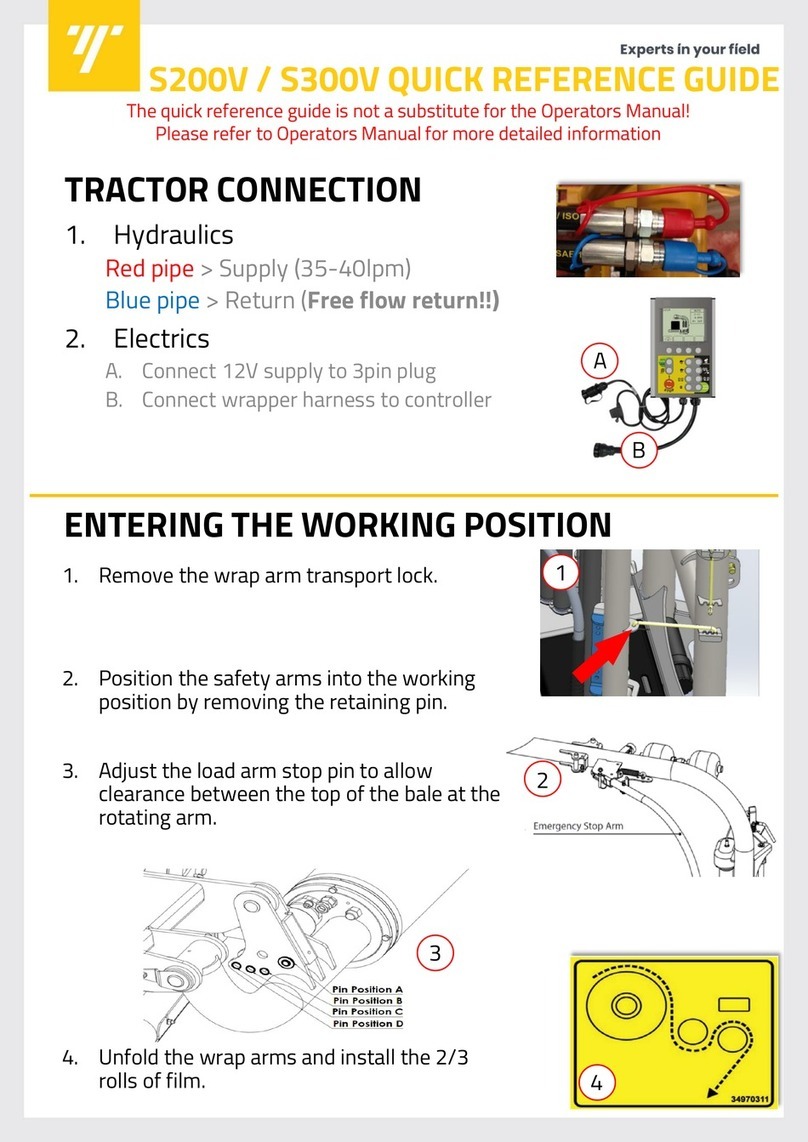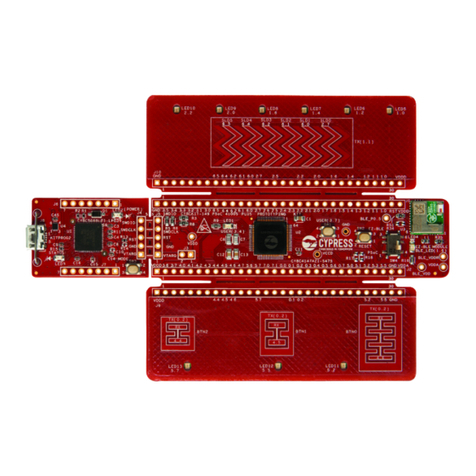EngA G-TRAC 1.1 User manual

A
IOM-24 March 1999 R1
INSTALLATION, OPERATION
AND MAINTENANCE MANUAL
FOR
G-TRAC
Model 1.1
INDIRECT FIRED HEATING CONTROLLER
UNIT MODEL NO.
_________________
UNIT SERIAL NO.
_________________
SERVICED BY: ___________________
TEL. NO:
________________________
CANADIAN
HEAD OFFICE
AND FACTORY
USA
HEAD OFFICE
AND FACTORY
CANADIAN
EASTERN FACTORY
1401 HASTINGS CRES. SE
CALGARY, ALBERTA
T2G 4C8
Ph: (403) 287-4774
Fx: 888-364-2727
32050 W. 83rd STREET
DESOTO, KANSAS
66018
Ph: (913) 583-3181
Fx: (913) 583-1406
1175 TWINNEY DRIVE
NEWMARKET, ONTARIO
L3Y 5V7
Ph: (905) 898-1114
Fx: (905) 898-7244
SALES OFFICES ACROSS CANADA AND USA
Retain instructions with unit and maintain in a legible condition.
Please give model number and serial number when contacting
factory for information and/or parts.
www.engineeredair.com

A G-TRAC MANUAL
IOM-24 Page i March 1999 R1
TABLE OF CONTENTS
I. PURPOSE ................................................................................................................ 1
II. CAUTION ................................................................................................................. 1
III. SIMPLIFIED OPERATION ....................................................................................... 1
IV. TEMPERATURE CONTROL .................................................................................... 2
G-TRAC as a Slave to the CTRAC ...................................................................................................... 2
Suggested Settings Re Hunting Problems ........................................................................................ 2
G-TRAC as a “Stand Alone Device” ................................................................................................... 2
V. MASTER SET-POINT .............................................................................................. 3
TE 6100 Wiring Connections and Resistance Values ...................................................................... 3
Sensor Resistance Chart for TE 6100-960 and TE 6000-960 ............................................................ 4
Temperature Can Be Controlled By ................................................................................................... 4
VI. RESET CONTROL ................................................................................................... 4
Example 1 ............................................................................................................................................. 5
Example 2 ............................................................................................................................................. 5
Example 3 ............................................................................................................................................. 5
Multiple Room Sensors ....................................................................................................................... 6
Room Reset Authority Pot .................................................................................................................. 6
VII. TO TEMPORARILY DRIVE THE UNIT TO HIGH OR LOW FIRE ............................ 6
VIII. G-TRAC DISCHARGE TEMPERATURE SENSOR/SETPOINT CALIBRATION ..... 6
Method 1 ............................................................................................................................................... 6
Method 2 ............................................................................................................................................... 7
IX. ROOM RESET CONTROL CALIBRATION ............................................................. 7
Method 1 (Most accurate method) ............................................................................................................ 7
Method 2 (Does not correct for remote wire resistance) ............................................................................. 7

A G-TRAC MANUAL
IOM-24 Page ii March 1999 R1
Method 3 ............................................................................................................................................... 8
Method 4 (May correct minor electrical noise on remote wire) ................................................................... 8
X. BMS RESET OF THE DISCHARGE AIR TEMPERATURE ..................................... 8
XI. POTENTIOMETERS ON THE G-TRAC ................................................................. 10
XII. DIAGNOSTIC LIGHTS ........................................................................................... 10
Heat Call Light .................................................................................................................................... 10
Pre-Purge Timer Light ....................................................................................................................... 11
Burner Enabled Light ........................................................................................................................ 11
XIII. TROUBLE SHOOTING .......................................................................................... 11
Supply Blower Not Starting .............................................................................................................. 11
No Heat (Burner Not Firing) ................................................................................................................ 12
Low Heat (Burner Firing) .................................................................................................................... 12
Unit Short of Temperature Rise ........................................................................................................ 12
Over Delivering Air ............................................................................................................................ 13
Inlet Gas Pressure Low or Burner Rumbles.................................................................................... 13
Regulator/Manifold Pressure Low or Slow to Respond ................................................................. 13
Gas Valve Won’t Open Fully (G-TRAC Slave to CTRAC) ................................................................... 13
Water and Ice From Combustion ...................................................................................................... 13
Over Heating ....................................................................................................................................... 14
Rapid Cycling of SA Contacts on G-TRAC Connected to BMS Reset .......................................... 14
G-TRAC not responding to BMS signal ........................................................................................... 14
Flame Failure Lockouts ..................................................................................................................... 14
“B” and “C” BURNER ELECTRODE DETAIL............................................................................15
XIV. CHANGING A G-TRAC IN THE FIELD .................................................................. 15
TO SET PRE-PURGE TIME DELAY ................................................................................................... 15
TO SET THE MAINTAIN PURGE TIME DELAY ................................................................................ 16

A G-TRAC MANUAL
IOM-24 Page iii March 1999 R1
ESTIMATED POT SETTINGS (Use for situations where design values not available) .............................. 16
Combustion Set Up ............................................................................................................................ 17
High Fire Combustion Set Up ....................................................................................................17
Low Fire Combustion Set Up .....................................................................................................17
Mid-Fire Range Combustion Set Up ..........................................................................................17
CHECK OUT FOR G-TRAC-1 NORMAL OPERATION .................................................... 18

A G-TRAC MANUAL
IOM-24 Page 1 March 1999 R1
A
G-TRAC
CONTROL FOR MODULATING DG UNITS
If you note any errors, omissions, or items that require further clarification, please contact Wade Pascoe at
(403) 287-4775 or Fax (403) 287-4799 or (403) 243-5059.
To ensure warranty is honoured, only a qualified HVAC service person or gas fitter thathasreceivedtraining
ontheG-TRAC,should be employed for service andtroubleshooting.Ifinformationisrequired please contact
the nearest Engineered Air office.
If conversion of degrees F to C is wanted, refer to table on page 4.
I. PURPOSE
The G-TRAC is designed to provide an accurate method of temperature control by modulating the size of the
flame on the DG Series heaters. It has been designed to operate with a variety of discharge control devices
and has the ability to utilize a room sensor for set point override control. The usual controls being applied to
the G-TRAC are arranged to Johnson Controls TE 6000/TE 6100 series or the G-TRAC is being operated as
a slave to the CTRAC. It is often applied to Gordon Piatt or Maxon Burner Systems.
II. CAUTION
The G-TRAC has a number of internal potentiometers. These are set up at the factory. These potentiometers
should not be field adjusted unless consultation has been made with someone who is familiar with the control.
Tampering may misalign the control operation resulting in poor combustion and/or poor temperature control or
calibration.
III. SIMPLIFIED OPERATION
24 V power to terminals "H" and "N"
36 seconds later terminals "SA" and "SA" make to start supply fan if the heat switch is not “on”.
NOTE: If the heat switch is already "on" there may be a further delay before the supply
blower starts while the heat starts.
Closing the remote heat switch places 24 V power to "HS" (heat switch).
If there is a call for heat from the temperature control device attached to the G-TRAC:
- As a safety procedure, the G-TRAC checks if "AS" is closed before the combustion blower starts. If it
is, then "CB" contacts will not close to start the combustion blower due to a closed air switch.
- If “AS” is open then "CB" to "CB" will close to start the combustion burner motor. Pre-purge is factory
set between 1 and 8 minutes. The length of pre-purge time is determined by the size of the heat
exchanger. (Jumper selection listed in Section XIV about replacing the G-TRAC.)
- The combustion blower moves air into the combustion chamber and the airflow closes the air switch
putting 24 volts on G-TRAC terminal "AS" (air switch).
- After pre-purge is complete "FR" to "FR" (flame relay) closes to power the flame relay for an ignition
attempt.
- If the supply blower had been shut off, "SA" to "SA" will close again 36 seconds after the pre-purge is
done to re-start the supply air fan. This is to allow for heat exchanger warm-up.

A G-TRAC MANUAL
IOM-24 Page 2 March 1999 R1
The flame relay (external to the G-TRAC) energizes the ignition transformer and pilot solenoid valve.
When the pilot is established, the flame relay will power the main gas valve and shut off the spark.
The G-TRAC and its associated controls maintain the discharge air temperature.
If the rise in discharge air temperature at low fire is greater than that required to satisfy the set-point, it is
necessary to cycle the burner on and off. The normal G-TRAC will likely cycle at about one minute intervals
and at a 20ºF-temperature swing when a low temperature rise is required. At extra cost the G-TRAC can be
tuned to "high sensitivity" which causes more burner cycling but gives better discharge control during
conditions when only a small increase is needed in discharge temperatures.
When higher temperature rise is required the G-TRAC will modulate the size of the flame rather than cycle
the burner. Note that burner cycling may occur in temperatures where theory suggests modulation should be
possible. This is caused by the mass of the heat exchanger, the time heat transfers to the air and the time for
the discharge temperature control device to react.
After a heat call is complete the combustion blower will remain in a "maintain purge” mode for 7 to 15
minutes (depending on jumper selection noted later). If the combustion blower is running it will allow a heat
call to start immediately without going through pre-purge.
IV. TEMPERATURE CONTROL
G-TRAC as a Slave to the CTRAC
In this application there is no temperature control sensor or set point attached to the G-TRAC. The G-TRAC’s
ability to control the firing rate is done with a 0 to 10 VDC volt signal from a CTRAC2.1 terminals "HD and B",
(0 to 8.5 VDC on the CTRAC2 version terminal "HT and B"). The CTRAC2.1 is the master control of the system.
G-TRAC heat call light will be activated when about a 4.5 VDC signal is received from the CTRAC. Terminal
HT to B are connected to D and W of G-TRAC. Refer to C-TRAC manual also.
Suggested Settings Re Hunting Problems
C-TRAC2.1 with G-TRAC with TE 6000-960 discharge sensor – may modulate through 20 degrees.
Set C-TRAC Pots Set G-TRAC Pots
P3 = 6 min. as high as 9
P6 = 5 ***
P11 = 2
P5 = 2
P6 = 4
P8 = 4
C-TRAC2.1 with G-TRAC and hyper sensor – may modulate whtough 10 degrees.
Set C-TRAC Pots Set G-TRAC Pots
P3 = 6 min. as high as 9 P5 = 2
P6 = 5 *** P6 = 4
P11 = 2 P8 = 4
*** On C-TRAC2.1 pot 6 does not exist.
G-TRAC as a “Stand Alone Device”
Either the internal set point or an external set point will be used as the discharge set point. Most installations
will use an external set point.
The usual discharge set-point control is a Penn TE 6100-960 control (which is both a set point and sensor, but
only the set point half is wired). The TE 6100-960 set-point device requires a cover such as T4000-264S. The
discharge sensor is a Penn TE 6000-960 sensor located in the discharge air stream.

A G-TRAC MANUAL
IOM-24 Page 3 March 1999 R1
V. MASTER SET-POINT
TE 6100 Wiring Connections and Resistance Values
As a SET POINT, the G-TRAC is designed to use either:
The set point pot 4 (auxillary setpoint) (range of 12-35°C or 55-95°F). If the G-TRAC pot 4 auxillary set-point
is used, terminals “SP and S” must be jumped, or;
The Johnson TE 6100-960 set point (range of 50-85°F and often remote mounted). If the TE 6100-960 is
used as a set-point, “S to SP” must not be jumpered and the TE 6100 must be wired:
TE 6100 Wires CTRAC2.1 Terminals
Violet (not used, sensor)
Blue U
Orange S
Grey M
Red (not used) Q
(No jumper S-SP)
TE6100-960 Sensor/Set Point
SENSOR (purple and blue) Same resistance as TE 6000-960
Set-Point Dialled To
60 degrees 90 degrees
POT
(orange and grey) 2.725 K 3.272 K
(orange and blue) 3.184 K 2.702 K
(blue and grey) 970
OTHER (purple and orange) 4.19 K 3.71 K
(purple and grey) About 1.981 K (varies with element temp.)
TE 6000 Sensor

A G-TRAC MANUAL
IOM-24 Page 4 March 1999 R1
TE 6000 SENSOR
SENSOR (purple and blue) Resistance in table below
Sensor Resistance Chart for TE 6100-960 and TE 6000-960
°C °F Resistance °C °F Resistance °C °F Resistance
-40 -40 602-605 18.3 65 983 48.9 120 1234
-34.4 -30 633 20 68 996 54.4 130 1269
-28.9 -20 665 20.6 69 1000.7 60 140 1333
-23.3 -10 698 21.1 70 1005 65.5 150 1365
-17.8 0 732 23.9 75 1026.5 71.1 160 1437
-12.2 10 768 26.7 80 1048 76.7 170 1491
-8.7 20 804 29.4 85 1070 82.2 180 1546
-1.1 30 842 32.2 90 1092 87.7 190 1602
4.4 40 881 35.6 95 1116 93.3 200 1659
10 50 921 37.8 100 1139 98.8 210 1718
12.8 55 941.5 43.3 110 1186 100 212 1778
Reference resistance is 1035 ohms at 77°F. Resistance tolerances are ±0.05 to 0.15% at 77°F. Temperature range +32 to
+104°F. (TE 6100-960 pot is 53C3, 500R, 7/8 by ¼ shaft.)
NOTE: Engineered Air’s design discharge temperature range is 30 to 140ºF.
Temperature Can Be Controlled By
DISCHARGE AIR CONTROL Consists of TE6000-960 duct sensor and set point (often
TE 6000-960) wired as above (or use the internal set point pot
4 with a jumper on “S to SP”).
DISCHARGE CONTROL WITH ROOM RESET Consists of duct sensor and set point wiring as noted
above with room sensor/set-point also connected to the G-
TRAC. (To activate this feature there must be a jumper from
terminals “RR and +”.)
Seldom used is control from a Honeywell T991A or equivalent control wired to terminals “D, U, M and V”
(R=D, W=U, B=M and V).
NOTE: To determine your system, refer to the unit wiring diagrams.
VI. RESET CONTROL
TE 6100 WIRE COLOUR C-TRAC2.1 TERMINAL PURPOSE
Room reset sensor/set-point
Blue Z Room reset set point +
Grey V Room reset set point
Orange Y Room reset centre tap
Violet X Room sensor
In a stand-alone system the G-TRAC operates as a discharge air control. If a room-reset control is used,
the room set point and sensor will modify the set point. This is best explained by an example. The room
reset ratio authority (pot 2) setting determines high and low discharge points.

A G-TRAC MANUAL
IOM-24 Page 5 March 1999 R1
Example 1
Discharge Room Room Reset High Discharge Low Discharge
Set point Set-point Ratio (Pot 2) Room Call Max Room Call Min
70ºF 72°F Pos 3 = 14 84°F 56°F
As the room temperature deviates from 72ºF it can modify the discharge temperatures up to as high as
84ºF and as low as 56ºF.
Example 2
Discharge Room Room Reset High Discharge Low Discharge
Set point Set-point Ratio (pot 2) Room Call Max Room Call Min
55ºF 72°F Pos 3 = + 14 69°F 41°F
As the room temperature deviates from 72°F it can modify the discharge temperature up to as high as 69°F
and as low as 41°F. Note you cannot reach a 72° room temperature. Also note that the internal design of
the G-TRAC will resist dropping the discharge temperature below 52°F.
Example 3
Discharge Room Room Reset High Discharge Low Discharge
Set point Set-point Ratio (pot 2) Room Call Max Room Call Min
63ºF 72°F Pos 4 + 18 81°F 45°F
This will allow discharge temperature as high as 81°F. If the room set point were turned up to 76°F we
would reset discharge to 81°F until the space temperature was raised to about 76°F. Also note that the
internal design of the G-TRAC will resist dropping the discharge temperature below 52°F.
NOTE: When dealing with systems that are equipped with room reset controls be aware
that any room sensor must be located in an area where it is sensing a true
average space temperature. A room reset that is located in a hot or cool area that
does not represent the room temperature willcreate room comfort problems. Also
do not locate the reset sensor in an area that is affected by discharge air from any
duct or other device. The G-TRAC terminals "RR and +" need to be jumped when
when the room reset is used. Note that on some wiring diagrams this may be
jumped during one mode and inactive in another.
TE
6000
TE6000
Grey
X
V
Orange
Blue
Built in
TE6100
TE6000
Violet

A G-TRAC MANUAL
IOM-24 Page 6 March 1999 R1
Multiple Room Sensors
Four sensors can be wired to give an average reading of room temperatures to the Trac cntrol. They must
be wired in a series/parallel arrangement. The drawing shows a circuit making use of the built in sensor in
the T#6100 Johnson Sensor/set point assembly and using TE6000 sensors for the other three. (The other
three could also be TE6100, just using the sensor wires)
Room Reset Authority Pot
Position Reset Amount Position Reset Amount
1 ±9°F 4 ±18°F
2 ±11°F 4.5 ±23°F
3 ±14°F 5 ±32°F
VII. TO TEMPORARILY DRIVE THE UNIT TO HIGH OR LOW FIRE
To force a G-TRAC to full heat, short the discharge sensor "Q" and "U".
To force a G-TRAC to low fire substitute a 1000 ohm resistor for the discharge sensor and adjust the set-
point pot to a point that just turns the heat call light on.
VIII. G-TRAC DISCHARGE TEMPERATURE SENSOR/SETPOINT CALIBRATION
Calibration is best done with supply fan on.
Method 1
Bring the G-TRAC to a stable discharge temperature by the following steps after disconnecting any override
devices. If the room reset option is wired on the unit you are working on you must disconnect the jumper
between “RR and +”. Note that all other potentiometer settings should be finalized before continuing with
this procedure. Calibration may be affected if other pots are adjusted after this procedure is complete.
Pivot
Point
RESET CONTROL
Discharge Temperature
Warm Discharge
Discharge Air Set Point
Cool Discharge
Room Hot
Room Cold
Room Temperature
Room Set Point

A G-TRAC MANUAL
IOM-24 Page 7 March 1999 R1
Jumper the combustion blower.
Jumper the flame relay terminals.
Place a Q209 Honeywell 140 ohm pot on the V9055 valve to modulate it to a fixed position and allow it
to run until discharge air temperature is stable in the modulated area of the valve stroke and between
55 to 90ºF.
Place a thermometer within one inch of the discharge sensor.
Set the TE 6100-960 set-point dial (or internal set point if used) to match the reading on the thermometer.
Adjust the G-TRAC calibration pot P1 until the heat call light just goes out.
Method 2
This description assumes the control is operating as an internal set-point control. (SP and P are jumped.) This
method does not correct for remote wire resistance.
Disconnect any external override controls (if room override option is used remove the "RR and +"jumperto
disable it.)
Set all pots to their required positions (except P1 and P3).
Allow the G-TRAC to run until it completes its pre-purge.
Set pot 4 to 70°F (21°C) (auxiliary set point).
Connect a 1005-ohm resistor in place of the discharge sensor. A resistor of this value represents a 70º-
discharge temperature. It should be wired to terminals "Q and U".
Adjust pot 1 until the heat light just shuts off. This places the G-TRAC in its dead band area.
Return the control to normal.
Assuming the control is operating with an external set point. Follow the above instructions except set the
remote TE 6100-960 sensor to 70°F (21°C).
If there is concern about doing this calibration in cool weather and drawing cold air into the building,
disconnect the wires to "FR and SA" to shut off the heat and supply air fan while the calibration is done.
IX. ROOM RESET CONTROL CALIBRATION
Method 1 (Most accurate method)
Remove the jumper between “RR and +”.
Remove the wires connected to “Z and X” and measure the resistance on them. Reconnect the wires to
“Z and X”.
Compare the resistance to that shown on the TE 6000 Sensor chart located in this manual.
Adjust the reset set point to the same value found in the above step.
Measure the voltage across “RR and +” and adjust pot 3 until the meter just reads a zero value (or in
absence of a meter, a less accurate method is to jumper “RR” and “+” and adjust pot 3 until the heat call light
just goes off).
Reconnect wiring to “RR and +”.
Method 2 (Does not correct for remote wire resistance)
Disconnect all room reset control terminals “V, X, Y and Z” from the G-TRAC. Connect a jumper across
the G-TRAC terminals "RR and +".

A G-TRAC MANUAL
IOM-24 Page 8 March 1999 R1
Place a 1005-ohm resistor across G-TRAC terminals "X and Z" to simulate 70°F (21°C).
Connect the TE 6100-960 set-point to the G-TRAC terminals as follows:
1. BLUE to G-TRAC terminal Z
2. ORANGE to G-TRAC terminal Y
3. GREY to G-TRAC terminal V
Turn the TE 6100-960 dial to 70°.
Adjust pot 3 until the heat light just shuts off
Method 3
Disconnect jumper from “RR and +”.
Set the discharge air calibration using a 1005-ohm resistor (to simulate 70°F) in place of the discharge
sensor. Adjust set point just short of where the heat call light comes on.
Accurately measure the room temperature next to the room sensor.
Set the room set point to the same temperature as was measured.
Ensure the jumper is re-installed "RR" to "+".
Adjust pot 3 until the heat call light is just short of coming on.
Method 4 (May correct minor electrical noise on remote wire)
Disconnect wires to terminals “Z and X” and measure the resistance on them. Reconnect the wires.
Compare the reading with the TE 6000 resistance chart in this document.
Adjust the room reset set-point dial to the same value as related to the chart. (Also ensure “RR and +”
are jumpered.)
Adjust pot 3 until the Heat Call light just comes on.
X. BMS RESET OF THE DISCHARGE AIR TEMPERATURE
The G-TRAC has the ability to accept an input from a BMS 0-10 VDC or 4-20 ma signal on the G-TRAC
terminals "+ and -". This is not optically isolated. Pot "P7" sets the amount of override that the BMS signal
will be allowed when the BMS signal is at its highest. Setting 1 is about ±32ºF and setting 5 is about ±60ºF.
The amount of reset authority may be slightly higher when using a 0 to 10 VDC reset signal from the BMS.
(Setting 1 = ±40ºF; setting 5 = ±75ºF).
Pot 7 Setting Reset Value With 0-10 VDC Signal 4-20 ma Signal
5 + 75°F + 60°F
4 + 68°F + 54°F
3 + 60°F + 48°F
2 + 50°F + 40°F
1 + 40°F + 32°F
Reset from the BMS signal will not be truly lineal. It will start to reset about 3 VDC. The reset will begin to
ramp gently at 3 volts and ramp more steeply as the reset voltage is increased.

A G-TRAC MANUAL
IOM-24 Page 9 March 1999 R1
Approximate relationship between 0-10 VDC and 4-20 ma signal.
VDC ma
0 0 Note: zero reset less than 2 VDC or less than 1 ma
2 3
4 8
5 10
6 12
8 16
10 20
There is a possibility of a grounded BMS signal that is not fully recognized by the G-TRAC. This occurs when
the BMS control signal’s negative wire and the G-TRAC’s 24 volt power supply both have a grounded
negative or common terminal. These are directly grounded, grounded through a transformer, or another point.
If the grounds are located at different places, it is possible to have different ground potentials or voltages. This
often shows up as a situation where the BMS signal is 10 VDC when not connected to the G-TRAC but falls
off to a much lower value when connected to the G-TRAC. The BMS signal may even fall low enough to drive
the calculated set point below the controls setting. It can also result in “SA-SA” contacts cycling and damage
the supply air motor or contactor.
If this is a problem:
1. Disconnect all grounds on the G-TRAC power supply transformer. Check the operation of the system.
2. If instructions above did not resolve the problem remove ground from the power supply transformer for
the V9055 gas valve controller.
3. Ensure the electrician properly grounded the unit to the building ground. Failure to do so may create
floating ground problems.
4. If there’s still a problem when these ground wires are removed, test operation of the G-TRAC with a fully
isolated power supply or use a 9 VDC battery to G-TRAC + and terminals. If this method will drive it,
the G-TRAC is OK. (A new 9 V battery will drive a G-TRAC for a few minutes.)
5. Ensure grounds from different control transformers are not mixed up.
NOTE:Fieldanalogcontrolinputsrequiresignalisolationtopreventground
loopsignalcorruptionand/ordamagetothecontroller(s).

A G-TRAC MANUAL
IOM-24 Page 10 March 1999 R1
XI. POTENTIOMETERS ON THE G-TRAC
P1 DISCHARGE CALIBRATION – Factory set as required. Do not readjust
without insuring that no reset signals are affecting discharge temperature
(Page 7).
P2 ROOM RESET RATIO – This sets the amount of authority the room reset
will have on the set-points desired discharge.
1=MIN RESET ±9º 5=MAX RESET ±32º
P3 ROOM CALIBRATION – Adjust as required if a room sensor is in use.
Ensure the discharge sensor is not affecting the signal (Page 8).
P4 AUXILIARY SET POINT – This pot is not normally used. If it is in use
there will be a jumper across "SP and S" or "SP and Y"
P5 VALVE SENSITIVITY – This adjusts the strength of the signal to the
valve. As it is set to a lower number, signal strength is higher and the valve
opens further. If this is not set to a low enough number (about 3) there may
not be enough drive to open the mod valve fully. If control is from a
CTRAC2.1 and valve cannot open fully, set lower until it does.
P6 INTERNAL CONTROL BAND – This pot selects a point above and below
set point that a modification is made to the valve output signal, which causes
it to react quicker. The amount of modification is not adjustable 1=10º/5=3º.
Usual setting is 3, but when G-TRAC is controlled by CTRAC set at 4.
P7 BMS RESET RATIO – Used on building management systems only.
Position 5 = +60, 1 = +32 on 4-20 MA BMS System
Position 5 = +75, 1 = +40 on 0-10 VDC BMS System
P8 BURNER ON/OFF CONTROL BAND – This sets the points at which the
burner cycles on and off. There is no delay off. Setting this control low
increases cycling. When control is from a CTRAC, usual setting is "4", setting
1 = 2ºF deadband, setting 5 = 6ºF.
To force the unit to High fire, short the discharge sensor "Q" and "U".
To force the unit to Low fire, substitute a 1000-ohm resistor for the discharge sensor and adjust the set-
point pot to just turn the heat call light on.
Regarding the above pot settings, note the following:
Pot 5 Do not set higher then 2.5 or 3 as there may not be enough power to drive the modulating gas valve
fully open. This pot regulates the response of the valve to the G-TRAC voltage signal. Three (3) is
the normal set point. Too low a set point may result in hunting due valve movement being too great
for the amount of signal change at the internal G-TRAC amplifier. This will result in unstable
discharge temperatures due to excessive hunting.
Pot 6 Operates in conjunction with pot P5. Normal set point is 3 and the set point when the G-TRAC is
controlled by a CTRAC is 4. Setting this pot too high can result in hunting.
XII. DIAGNOSTIC LIGHTS
To simplify troubleshooting and to see what the unit is doing at the moment, there are a number of "LED"
lights.
Heat Call Light
Indicates that the discharge sensor and/or any of the reset devices wired to the G-TRAC are calling for more
heat.
4
5
3
2 1
4
5
3
2 1
4
5
3
2 1
85
95
72
64
55
4
5
3
2 1
4
5
3
2 1
4
5
3
2 1
4
5
3
2 1

A G-TRAC MANUAL
IOM-24 Page 11 March 1999 R1
Pre-Purge Timer Light
The pre-purge timer light will activate when there is a call for heat and the burner is in the pre-purge mode.
The combustion blower should be running but there should be no flame. When this light goes out, if the heat
call is still present, the burner-enabled light will come on. Note that pre-purge time is pre-set at the factory.
The higher the burner turn down and the larger the heat exchanger, the longer the pre-purge. Pre-purge time
is set by cutting jumpers as noted in Section XIV about field replacement of the control.
Burner Enabled Light
Pre-purge time is complete. The burner should be firing and will maintain discharge temperature as per the
control system wired to the G-TRAC.
XIII. TROUBLE SHOOTING
Supply Blower Not Starting
G-TRAC DIAGNOSTIC LIGHTS
HEAT
CALL
PRE-
PURGE
TIMER
BURNER
ENABLE
COMBUS-
TION
BLOWER
OPERATING CONDITIONS OR
PROBLEM DIAGNOSIS
OFF OFF OFF OFF Check for 24 VAC on terminals “H and
N”. Allow 45 seconds for fan start up.
ON OFF OFF OFF Check for shorted combustion air switch.
ON ON OFF OFF Check combustion blower motor circuit ***
ON ON OFF RUNNING Normal for morning start up. Supply fan is
held off by pre-purge cycle XXX
ON OFF OFF ON No power to A/S terminal. Check for open
A/S or failed combustion fan.
OFF OFF OFF ON Pre-purge complete. No heat call, S/A fan
will start in 36 seconds.
ON OFF ON ON Blower will start in 36 seconds.
*** This condition is unlikely to occur. If the combustion blower stops, The air switch (AS) will open circuit and
the pre-purge light will go off.
XXX If this is the first start and the discharge air sensor is warm but the O/A is cool, then the supply fan may not
start for 36 seconds or it may cycle.

A G-TRAC MANUAL
IOM-24 Page 12 March 1999 R1
No Heat (Burner Not Firing)
G-TRAC DIAGNOSTIC LIGHTS
HEAT
CALL
PRE-
PURGE
TIMER
BURNER
ENABLED
COMBUS-
TION
BLOWER
OPERATING CONDITIONS OR PROBLEM
DIAGNOSIS
OFF OFF OFF OFF
No heat call. Check if “HS” is powered.
Check discharge and/or reset sensors and
set points.
ON OFF OFF OFF Shorted combustion air switch or faulty
combustion fan motor.
ON OFF OFF RUNNING Is there power on terminal “AS”? If not, is air
switch open?
ON ON OFF RUNNING
Unit running in pre-purge, which lasts 1 to 8
minutes. If pre-purge light stays on, G-TRAC
may be faulty.
ON OFF ON RUNNING
Check for flame failure and/or power to flame
relay. G-TRAC thinks all is operating okay
and heat is on.
OFF OFF OFF RUNNING
No heat call. G-TRAC has finished firing and
is in "maintain purge" mode for 1 to 15
minutes. If it stays like this, check sensors,
set points, resets, and calibration.
OFF ON OFF RUNNING
There has been a short heat call. Check for
intermittent wiring, electrical noise,
intermittent sensors, set points, or rapidly
changing BMS Signals. ***
*** Shielded wire should be used on all sensors and remote thermostats.
Low Heat (Burner Firing)
G-TRAC DIAGNOSTIC LIGHTS
HEAT CALL PRE-PURGE
TIMER
BURNER
ENABLED
COMBUS-
TION
BLOWER
OPERATING CONDITIONS OR
PROBLEM DIAGNOSIS
EITHER OFF EITHER RUNNING Check discharge and/or reset sensors
and set-point calibration.
ON ON OFF RUNNING
Unit is on pre-purge. If unit does not start
within 1 to 8 minutes, the G-TRAC may
be faulty.
ON OFF ON RUNNING Is unit over delivering supply air or is inlet
gas pressure low? ***
*** Inlet gas pressure should not fall to less than 6” on a 7” system or less than 13” on a 14” system when the unit is at
high fire.
NOTE: The following are some possibilities that are associated with lack of heat output
from G-TRAC’s.
Unit Short of Temperature Rise
If inlet gas pressure, manifold gas pressure and combustion are correct, note below, “Over Delivering Air”.

A G-TRAC MANUAL
IOM-24 Page 13 March 1999 R1
Over Delivering Air
At the time of installation and air balancing, the unit is often set-up in warmer weather then the design
temperature rise. If the air balancer did not allow for the changes that will occur in air volume in cold weather
then the unit will appear to be short of temperature rise. As the fan is a constant volume device and as it is
located before the heat exchanger, air will expand as it is heated. The amount of change will be about 20%
increase in air volume from minus 30° F to 70° F. Therefore to give a rough sample, assuming a 10,000 CFM
100% fresh air unit (located in an area that reaches -30°F in the winter) was being air balanced on a 75ºF day
with the heat off. The unit design temperature rise is 100ºF. It should be balanced to deliver about 8,200
CFM. On a day that is -30°, the fan is still delivering 8,200 CFM onto the heat exchanger, but as the air
expands over the exchanger there is 10,000 CFM coming off of the unit. Temperature rise should meet the
100° design to give a discharge temperature of 70°. (If the unit had been balanced to deliver 10,000 CFM on the
75°day, then on the -30°day noted above, the temperature rise would only be about 80°to give a final discharge
temperature of about 50°at about 11,800 CFM.)
Inlet Gas Pressure Low or Burner Rumbles
DG burners must have adequate inlet gas pressure. The temperature rise
will be affected if gas pressure falls below 6.5 inches on units designed for
7-inch inlet pressure. On units designed for 14-inch gas pressure inlet
pressure cannot fall below 12-inches. These pressures must be measured
at high fire conditions. Burner manifold pressure must be measured on tap
for Gordon Piatt Burners.
On some indoor units the vent orifice fitting on the RV appliance regulator
is to be vented to atmosphere. The field installed vent line should be sized
adequately especially on longer runs. If there is more than one regulator connected to a common run that
includes the main regulator, and the line is not adequately sized, an erratic inlet pressure will result and cause
improper combustion and also burner pulsating problems.
Some SJ unit manifolds have RV appliance regulators with a vent limiting orifice (usually a brass orifice
marked “12A06”). Ensure that this tiny orifice is free of dirt or debris. A plugged orifice will impede a regulators
opening flow and cause improper air/fuel mixtures.
Regulator/Manifold Pressure Low or Slow to Respond
If the orifice or tube in the top of the regulator is plugged, this may stop regulator from responding.
Gas Valve Won’t Open Fully (G-TRAC Slave to CTRAC)
This problem seldom occurs at initial daily start-up. It is usually triggered by some unknown sequence of
events. At first the system operates normally, then suddenly (usually after leaving a heat call on the CTRAC and
then re-establishing the heat call) the G-TRAC does not respond normally to the incoming voltage from the
CTRAC. If there is a full call for heat from the CTRAC heat output ramp but the G-TRAC does not fully open
the modulating valve:
Ensure sensors are in shielded wire.
Isolate CTRAC and G-TRAC 24 VAC power supplies.
If that does not resolve the problem decrease the setting on the G-TRAC pot 5 from 3 to a lower value.
Usually setting it to 2 is enough though occasionally you must set pot 5 as low as 1.
Water and Ice From Combustion
These heat exchangers are very efficient. Water is one of the major products of combustion and as such must
be controlled. The units are equipped with a drain. It is however best to allow water to leave the unit in the
flue gases in vapor form. Combustion that is set at maximum efficiency will produce excess moisture. Often it
is desirable to have 1% to 2% higher excess oxygen readings then those normally listed to assist in keeping
the flue gases drier. Also note that extended chimneys can contribute to condensation problems (especiallyif
they are not insulated or at least double walled). Water in the heat exchanger can lead to premature failure due to
thermal stress or freezing. Another source of excess condensation is when a unit designed with capacity to
M
anifold
P
ressure Tap

A G-TRAC MANUAL
IOM-24 Page 14 March 1999 R1
heat 100% outside air is operating with very little outside air, therefore operating at a low fire or cycling. This
allows the cool flue gases from low fire to cool and condense in the chimney.
Over Heating
G-TRAC DIAGNOSTIC LIGHTS
HEAT
CALL
PRE-
PURGE
TIMER
BURNER
ENABLED
COMBUSTION
BLOWER
OPERATING CONDITIONS OR
PROBLEM DIAGNOSIS
ON OFF ON RUNNING
CHECK DISCHARGE AND/OR
RESET SENSORS AND
SETPOINT CALIBRATION
OFF EITHER ON EITHER FAULTY G-TRAC
Rapid Cycling of SA Contacts on G-TRAC Connected to BMS Reset
If a problem exists with the supply air fan rapid cycling during the first start up of the day and the G-TRAC is
connected to a BMS system, there can be some interference. During the off cycle the warm air in the space
may vent back to the unit keeping the discharge air sensor warmer than the internal set-point (EG: set at 65°F).
When the unit is turned on in the morning, the BMS reset would be at zero VDC or 4 Ma at “+ and –“ on the
G-TRAC terminals. It is therefore demanding a 65°F air discharge temperature. As the temperature in the
discharge plenum was warmer then 65°F, the G-TRAC would not call for heat, the fan will start in 34 seconds.
As soon as the fan starts, a current transformer, (supplied and installed by others) to prove our fan is running,
sends a signal to the BMS panel. This proves that the unit is now on, which in turn allows the BMS to ramp its
signal to 10VDC to the + and - terminals of the G-TRAC (because the space temperature was cool from the
unoccupied cycle the night before).
This of course results in a call for heat, and cycles the fan off in order for the heat exchanger to warm up.
Voltage to + and - would then go to O VDC, again resulting in no call for heat and the cycle will then repeat.
Note that some DDC or BMS panels must have a positive proof of fan operating before reset voltage is
ramped up.
Installing a relay in parallel with the day/night terminal can rectify this problem. Use a VTM time delay and the
DPDT relay contacts (such as a Honeywell R8222). This will lock out the BMS signal for minimum of 3 minutes.
The 3 minutes is required to give the G-TRAC an opportunity to get into its normal operating mode.
G-TRAC not responding to BMS signal
Refer to the section on BMS above and Section X.
Flame Failure Lockouts
The G-TRAC does not have direct control of the flame supervision. That is usually the task of a Fireye M
Series II Flame Supervision Relay. For most problems refer to the Fireye (or other flame supervision device)
instructions. The following are a couple of items not covered on their manual.
1. If the combustion air damper is open when the burner starts, it can blow out the pilot flame as it tries to
light. Ensure that the spring used to close the damper is operating correctly. The spring is usually found
behind the gas valve and is attached to the gas valves damper linkage. (A few units do not have a spring,
they have a counter-weight).
2. A very quick interruption of the power can cause a flame failure. The length of time of power failure is less
then ½ second but longer then 1/1000 of a second.
3. A situation that allows for a flame to continue to burn after a heat call is complete, and if that flame is
impinging on the flame rod, can lead to a flame failure if another heat call is made while the flame signal
still exists. We call this a residual flame and it is possible due to the quantity of gas in the main manifold

A G-TRAC MANUAL
IOM-24 Page 15 March 1999 R1
after the main shut off valve still flowing due to its pressure and airflow patterns. Possible solutions to
stop flame failures due to residual flame are:
A. Slightly increase the quantity of low fire air to the burner to blow out the residual flame.
B. Reduce or eliminate the flame around the flame rod by removing the source of the fuel. It is possible
the fuel source is the nozzle located at 3 o’clock on the diffuser plate. Try to temporarily block this
nozzle and note the results.
C. Place a time delay relay into the FR flame relay circuit to not allow the flame relay to pull in until the
residual flame has burnt out. (Usually 30-60 seconds).
D. Cracked spark and flame rods.
E. Proper positioning of the spark rod in relation to the pilot orifice and the depth of the pilot stub past
the burner retention plate is very important (see sketch below).
F. A poor ground path can contribute to flame failure problems. If this is suspected a ground wire can be
screwed onto the retention plate and then connected to ground screen marked on the Fireye sub-
base.
“B” and “C” BURNER ELECTRODE DETAIL
All Gas Ignition Electrode Require ” Gap for Sparking.
XIV. CHANGING A G-TRAC IN THE FIELD
TO SET PRE-PURGE TIME DELAY
Pre-purge time delay is set by cutting the pre-purge jumpers on the back of the G-TRAC board. This is best
to do before installing a new board. Cut the same jumpers as were cut on the old board or contact the
factory (after getting unit serial number) for correct jumper information. Pre-purge time is determined by the
size of the heat exchanger and the time required to vent it.
The number in the brackets is the jumper wire setting. (0 = cut; 1 = uncut). The first digit refers to PP1,
second to PP2, etc. Time is in MIN: SEC

A G-TRAC MANUAL
IOM-24 Page 16 March 1999 R1
Time (Jumpers) Time (Jumpers) Time (Jumpers) Time (Jumpers)
0:0 (1111) 0:15 (0111) 0:45 (1011) 1:15 (0011)
1:45 (1101) 2:15 (0101) 2:45 (1001) 3:15 (0001)
3:45 (1110) 4:15 (0110) 4:45 (1010) 5:15 (0010)
5:45 (1100) 6:15 (0100) 6:45 (1000) 7:15 (0000)
TO SET THE MAINTAIN PURGE TIME DELAY
Maintain Purge Time Delay is set by cutting the “maintain purge” jumpers on the back of the G-TRAC
board. This is best to do before installing a new board. Cut the same jumpers as were cut on the old
board or contact the factory (after getting unit serial number) for correct jumper information. Maintain purge
time is determined by the speed that heat exchangers lose heat and control systems react. If purge has
turned off and there is another call for heat, then pre-purge must occur again which may create wide
discharge temperature swings. Turning the combustion fan off is only done as an energy management
step.
JUMPER CONNECTIONS
APPLICATION TIME IN
MINUTES MP-1 MP-2 MP-3 MP-4
ONLY ROOM
CONTROL 0:30 CUT JUMPER JUMPER JUMPER
MOST
APPLICATIONS 6.30 CUT CUT CUT JUMPER
CTRAC
CONTROL 2:30 CUT CUT JUMPER JUMPER
Cutting all MP jumpers allows a "maintain purge" time of 12 minutes (plus or minus 2 minutes).
ESTIMATED POT SETTINGS (Use for situations where design values not available)
If the old G-TRAC is available, there was a sticker inside the cover showing the pot settings as they left
our factory. If this is not available and the control was operating well before it failed, then match the pot
settings. Failing that:
POT 5 Valve Sensitivity Set at 3 (or slightly lower)
POT 6 Internal Control Band set at 3 (If G-TRAC is slave to a CTRAC then set this at 4)
POT 8 Burner ON/OFF Control Band If G-TRAC is slave to a CTRAC then set this at 4
POT 4 Auxiliary Set point Usually not used. Used only if there is a jumper “SP to
S” (main set-point) or “SP to Y” (reset set-point)
POT 1 Discharge Calibration Must be set as per instruction in manual
POT 3 Room Calibration Must be set as per instruction in manual. This is usually
as a room or return air reset rather than as room control.
Used only if V, X, Y, Z are wired
POT 2 Room Reset Ratio Used only if POT 3 is used. Used to determine how
much authority will be given to the reset
thermostat/sensor. Setting 1 is the minimum authority
(+/- 9ºF) and setting 5 is the maximum authority (+/-
32ºF).
POT 7 BMS RESET RATIO Used only if there is a BMS control wired to the BMS
input terminals “+ and –“ (1 is minimum reset authority and
5 is maximum authority).
Table of contents
Other EngA Controllers manuals
Popular Controllers manuals by other brands
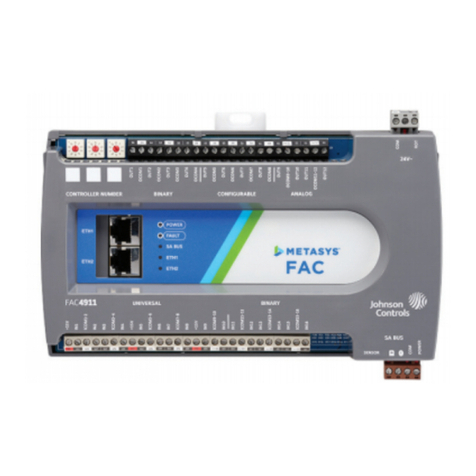
Johnson Controls
Johnson Controls Metasys FAC4911 installation guide
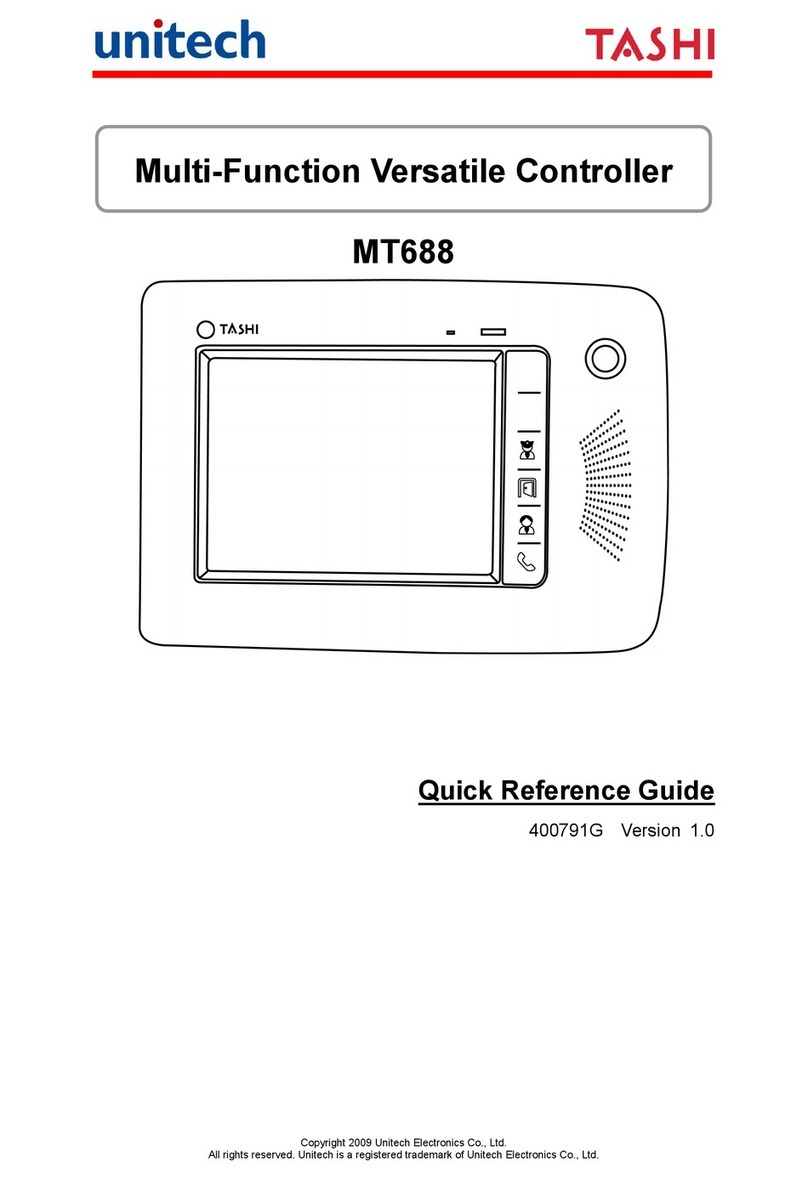
Unitech
Unitech Tashi MT688 Quick reference guide
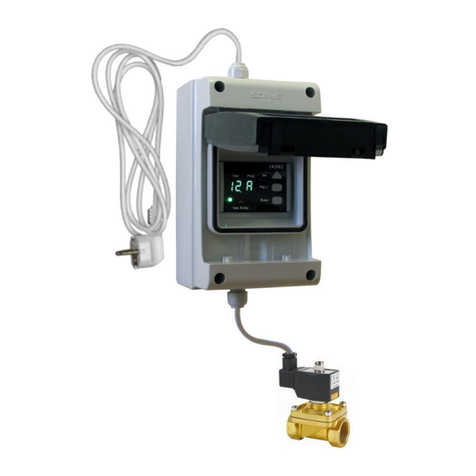
Intiel
Intiel AQUA FILTER INT010 user guide
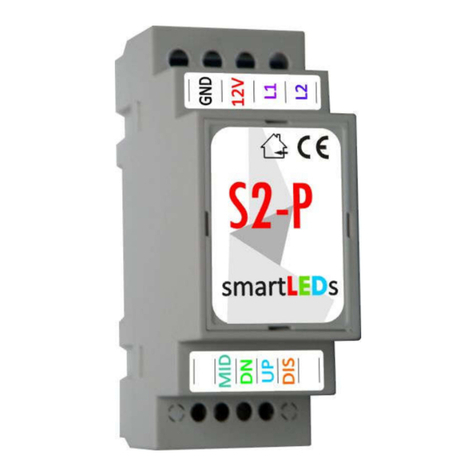
APACHETA
APACHETA smartLEDs S2-P user manual
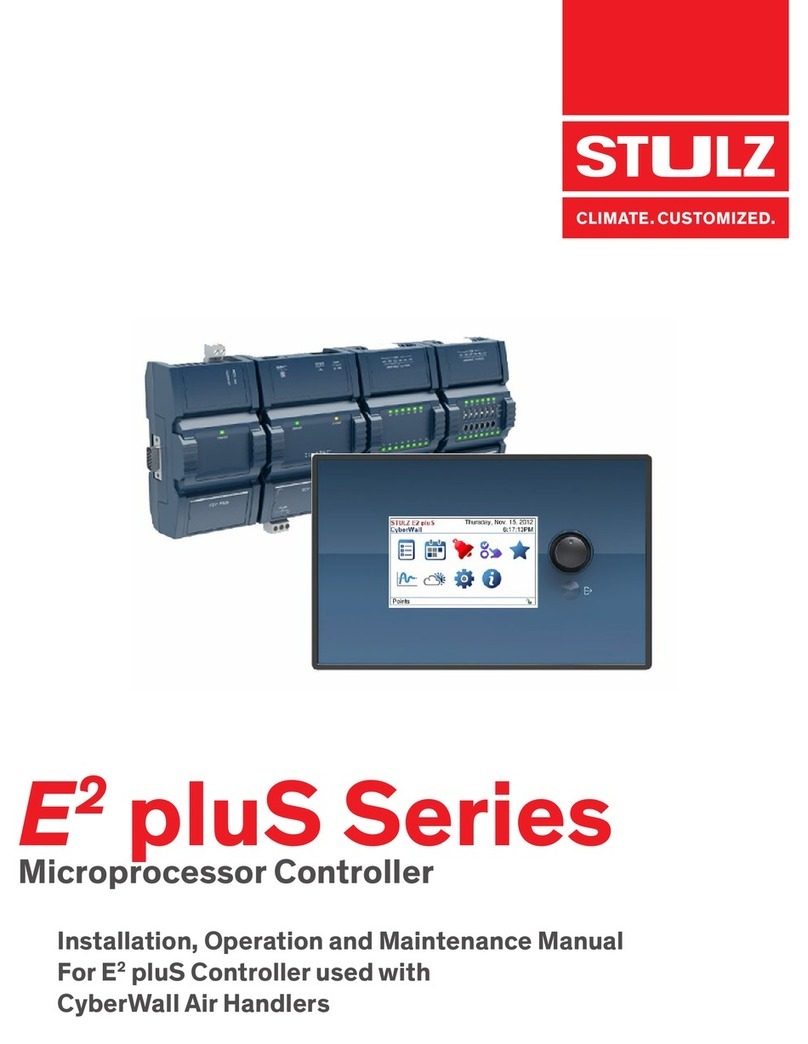
Stulz
Stulz E2 pluS Series Installation, operation and maintenance manual
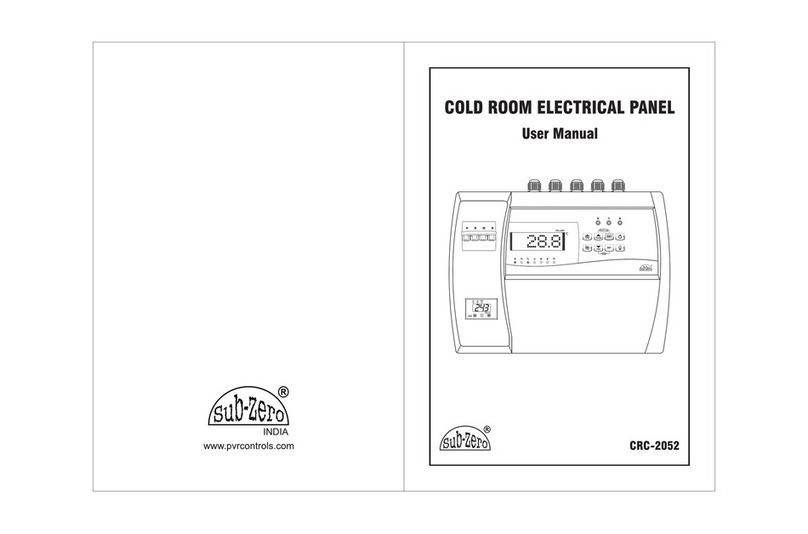
Sub-Zero
Sub-Zero CRC-2052 user manual
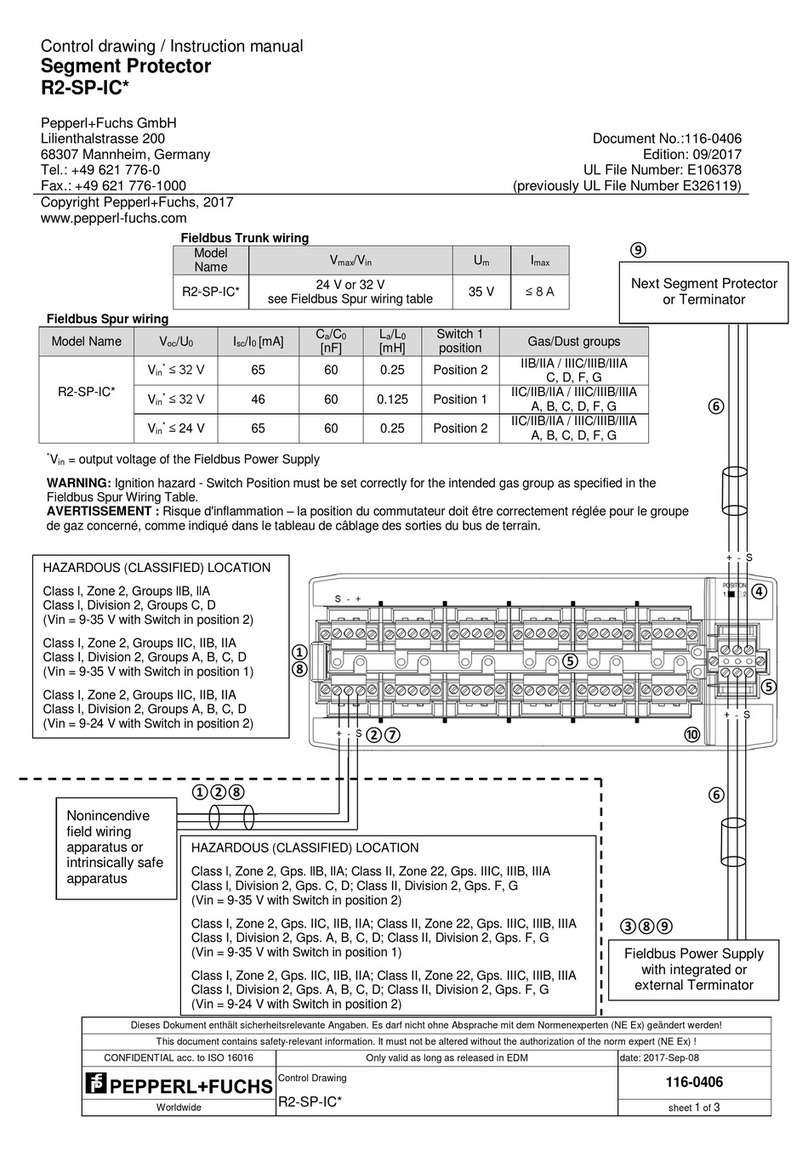
Pepperl+Fuchs
Pepperl+Fuchs R2-SP-IC Series Control drawing / Instruction manual
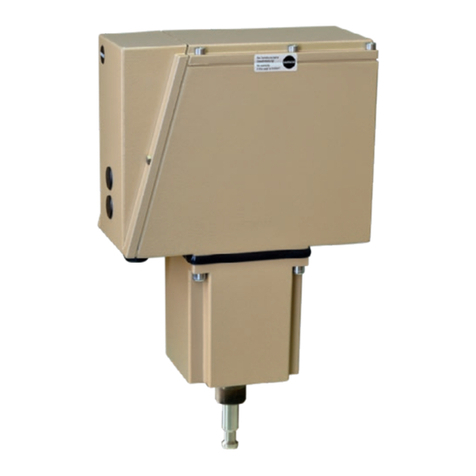
Samson
Samson 3274 Mounting and operating instructions
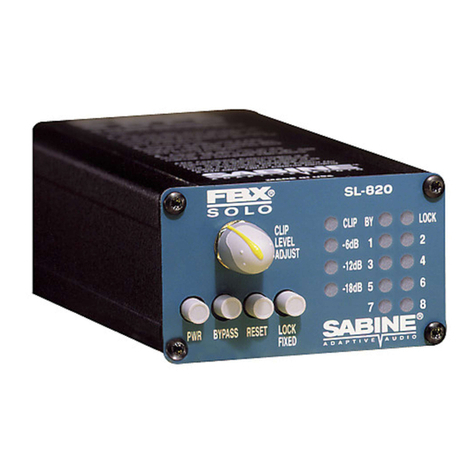
SABINE
SABINE SL-820 operating guide
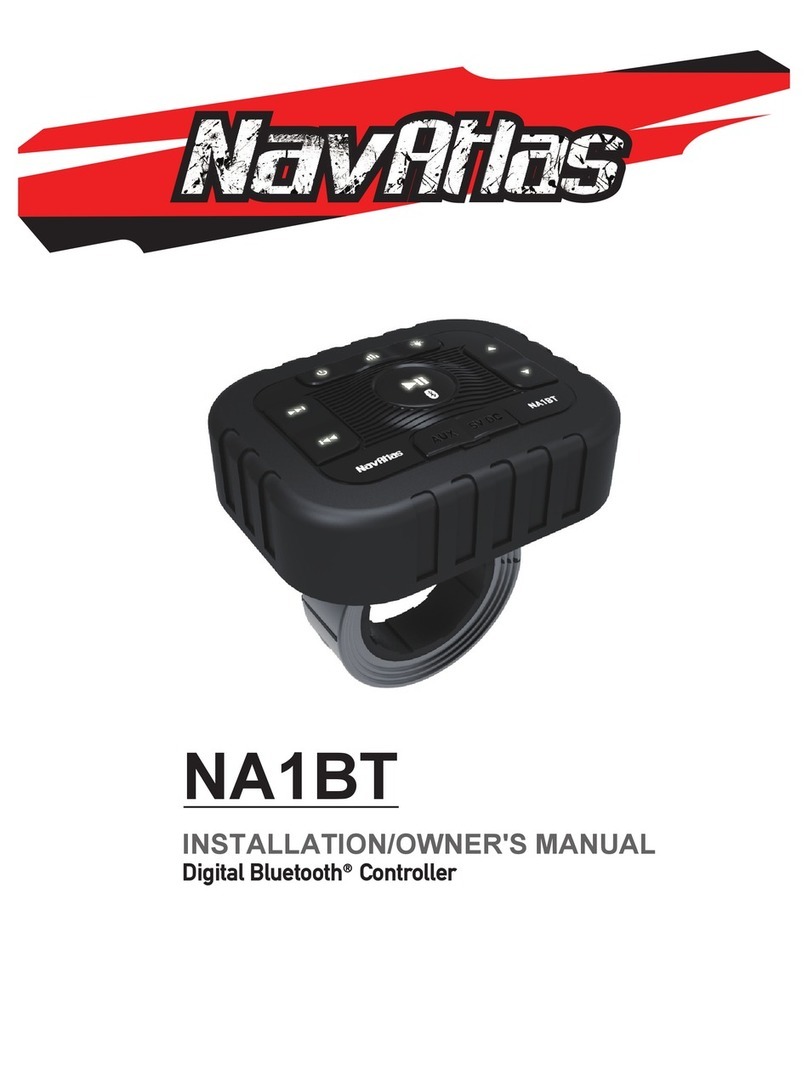
NavAtlas
NavAtlas NA1BT Installation & owner's manual
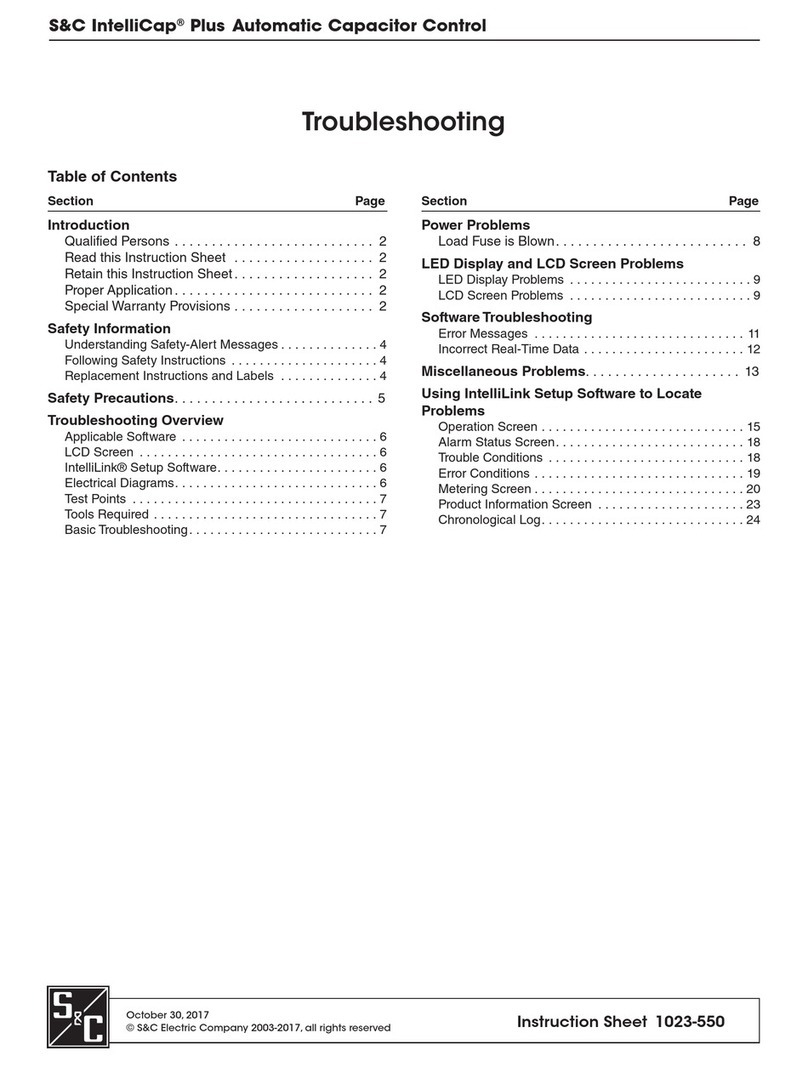
S&C
S&C IntelliCap Plus Troubleshooting

Chauvet Professional
Chauvet Professional RDM2go Quick reference guide
